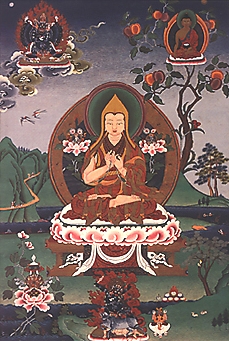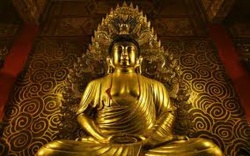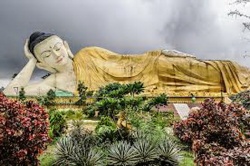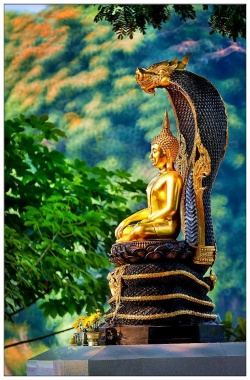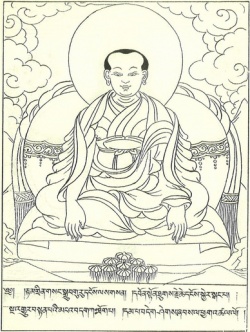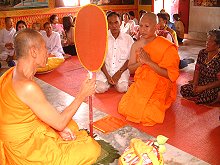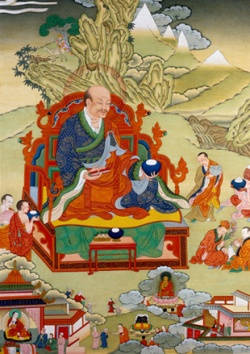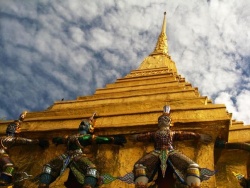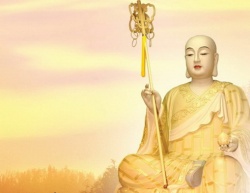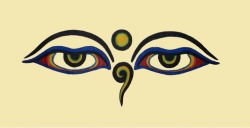Je Tsongkhapa
Click here to see other articles relating to word Je Tsongkhapa
Tsongkhapa (1357–1419), whose name means “The Man from Onion Valley”, was a famous teacher of Tibetan Buddhism whose activities led to the formation of the Gelug school.
He is also known by his ordained name Lobsang Drakpa (blo bzang grags pa) or simply as Je Rinpoche (rje rin po che).
Tsongkhapa heard Buddha’s teachings from masters of all Tibetan Buddhist traditions, and received lineages transmitted in the major schools.
His main source of inspiration was the Kadampa tradition, the legacy of Atiśa. Based on Tsongkhapa’s teaching, the two distinguishing characteristics of the Gelug tradition are:
Early years
[[Image:Tsongkhapa.Kumbum.jpg|thumb|left|Statue of Tsongkhapa, founder of the Gelugpa school, on the altar in his temple (his birth place) in Kumbum Monastery, near Xining, Qinghai (Amdo), China.
Born into a nomadic family in Amdo province in 1357, Tsongkhapa received the layman ordination (skt. Upasaka) at the age of three from the 4th Karmapa, Rolpe Dorje, and was entitled “Kunga Nyingpo” (kun dga’ snying po).
At the age of seven he took the novice ordination (skt. Sramanera, tib. Getsul) from Choje Dhondup Rinchen (chos rje don ’grub rin chen) and was given the name “Lobsang Drakpa” (blo bzang grags pa).
It was at this early age that he was able to receive the empowerments of Heruka Chakrasamvara, Hevajra, and Yamantaka, three of the most prominent wrathful deities of Tibetan Buddhism, as well as being able to recite a great many Sutras, not the least of which was Manjushri-nama-samgiti.
He would go on to be a great student of the Buddhist Vinaya, the Doctrine of behaviour, and even later of the Six Yogas of Naropa, the Kalachakra Tantra, and the acclaimed practice of Mahamudra.
At the age of 24 Tsongkhapa received the ordination of a full Monk (skt. Bhikshu, tib. Gelong) in the Sakya Tradition.
From Zhönnu Lodrö (gzhon nu blo gros) and Rendawa (red mda’ pa) he received the lineage of the Pramanavarttika transmitted by Sakya Pandita (sa skya Pandita).
He mastered all the courses of study at Drikung Monastery in Central Tibet, a major Kagyü Center, and travelled extensively in search of Knowledge, studying with more than 100 teachers of all the existing traditions all topics of the Doctrine, including Dzogchen.
Tsongkhapa, who was considered by many as an emanation of Atisha, received the Kadam lineages, and studied the major Sarma (gsar ma) Tantras (the Tantras from the “New Translation School”) under Sakya and Kagyü masters.
He also studied with Nyingma Siddha Legpey Dorje (Wylie: legs gyi rdo rje), and the Zalupa Chökyi-pal (zha lu pa chos kyi dpal), and his main Dzogchen master was Lodrak Drupchen Kekyi Dorje (lho brag grub chen las kyi rdo je), also known as Namkha Gyaltsen (nam mkha' rgyal mtshan, 1326-1401).
In addition to his studies, he engaged in extensive Meditation retreats. He is reputed to have performed millions of prostrations, Mandala offerings and other forms of purification practice.
Tsongkhapa often had visions of meditational deities and especially of Manjushri, with whom he would communicate directly to clarify difficult points of the scriptures.
He was effective as a teacher in Tibetan Buddhism and became a leading figure amongst his peers as well as his students.
Many of his teachers eventually joined him as students, such as Rendawa, Umapa, the Nyingma Lama Lhodrak, and they taught and revered each other. Revered as having strong influence, Compassion, and Wisdom he is referred to as a second Buddha.
Eight Great Difficult Points
Tsongkhapa’s dictated 'Notes on the Eight Great Difficult Points of the Mūlamadhyamakakārikā' (Wylie: ba shes rab kyi dka’ gnad chen po brgyad kyi brjed byang) were transcribed by his disciple rGyal-tshab-rje.
The fifth point contends with 'apperception' (Wylie: Rang rig).
Legacy
[[Image:Tsong-Khapa-Je-Tsongkhapa.jpg|left|thumb|Bronze depicting Tsongkhapa, who is known and revered by Mongolians as Bogd Zonkhov. With the founding of the Ganden monastery in 1409, he laid down the basis for what was later named the Gelug ("virtuous ones") order. At the time of the foundation of the Ganden monastery, his followers became to be known as "Gandenbas."
Tsongkhapa himself never announced the establishment of a new monastic order.
Tsongkhapa’s teachings drew upon the teachings of Atisha, emphasizing the study of Vinaya, the Tripiṭaka, and the Shastras.
Atisha’s Lamrim inspired Tsongkhapa’s Lamrim Chenmo, which became a main text among his followers.
He also practiced and taught extensively the Vajrayana, and especially how to bring the Sutra and Tantra teachings together,
wrote works that summarized the root teachings of the Buddhist philosophical schools, as well as commentaries on the Pratimoksha, Prajnaparamita, Candrakirti’s Madhyamakavatara, logic, and the Sarma Tantras.
Tsongkhapa emphasised a strong monastic Sangha.
Furthermore, he promoted the study of logic, encouraged formal Debates as part of Dharma studies, and instructed disciples in the Guhyasamaja, Kalacakra, and Hevajra Tantras.
Tsongkhapa was one of the foremost authorities of Tibetan Buddhism at the time.
He composed a devotional prayer called the Migtsema Prayer to his Sakya master Rendawa, which was offered back to Tsongkhapa, with the note of his master saying that these verses were more applicable to Tsongkhapa than to himself.
After Tsongkhapa's passing away, several biographies were written by Lamas of different traditions, and they all agreed that he was a teacher without parallel.
The 9th Karmapa, Wangchuk Dorje, praised Tsongkhapa as one "who swept away wrong views with the correct and perfect ones."
The 8th Karmapa, Gyalwa Mikyö Dorje, wrote in his poem In Praise of the Incomparable Tsong Khapa:
- When the teachings of the Sakya, Kagyue, Kadam
- And Nyingma sects in Tibet were declining,
- You, O Tsong Khapa, revived Buddha's Doctrine,
- Hence I sing this praise to you of Ganden Mountain.
Further, it is said that The Buddha Sakyamuni spoke of his coming as an emanation of the Bodhisattva Manjusri in the short verse from the Root Tantra of Manjushri (Tib. 'Jam-dpal rtsa-rgyud):
- After I pass away
- And my pure Doctrine is absent,
- You will appear as an ordinary being,
- Performing the deeds of a Buddha
- And establishing the Joyful Land, the great Protector,
- In the Land of the Snows.
Although Tsongkhapa would finally pass away in 1419 at the age of sixty-two, he left to the World 18 volumes of collected teachings, with the largest amount being on Guhyasamāja tantra.
These 18 volumes contain hundreds of titles relating to all aspects of Buddhist teachings and clarify some of the most difficult topics of Sutrayana and Vajrayana teachings.
Major works among them are:
- The Great Exposition of the Stages of the Path (lam rim chen mo),
- The Great Exposition of Tantras (sngags rim chen mo),
- The Essence of Eloquence on the Interpretive and Definitive Teachings (drang nges legs bshad snying po; full title: gsung rab kyi drang ba dang nges pai don rnam par phye ba gsal bar byed pa legs par bshad pai snying po),
- The Praise of Relativity (rten ’brel bstod pa),
- The Clear Exposition of the Five Stages of Guhyasamaja (gsang ’dus rim lnga gsal sgron) and
- The Golden Rosary (gser phreng).
These scriptures are the prime source for the studies of the Gelugpa tradition and these and other teachings of Tsongkhapa endured into the modern age and are seen as a protection against misconceptions in Mahayana and Vajrayana Buddhism.
The 14th Dalai Lama has highlighted the fidelity of Tsongkhapa's work to the meaning found in Buddhapalita’s work. Tsongkhapa’s work is praised as being profound and true to tradition, essentially a clarification and condensation of the transmitted teachings, which after all, are intended to encapsulate unchanging Truth.
After Tsongkhapa had founded the monastery of Ganden in 1409, it became his main seat.
He had many students, among whom Gyaltsab Dharma Rinchen (1364–1431),
Khedrup Gelek Pelzang (1385–1438),
Togden Jampal Gyatso,
Jamyang Choje,
Jamchenpa Sherap Senge,
and the First Dalai Lama, Gyalwa Gendün Drup (1391–1474), were the most outstanding.
After Tsongkhapa’s passing his teachings were held and kept by Gyaltsab Dharma Rinchen and Khedrub Gelek Pälsang.
From then on, his lineage has been held by the Ganden Tripas, the throne-holders of Ganden Monastery, among whom the present one is Thubten Nyima Lungtok Tenzin Norbu, the 102nd Ganden Tripa.
After the founding of Ganden Monastery by Tsongkhapa, Drepung Monastery was founded by Jamyang Choje, Sera Monastery was founded by Chöje Shakya Yeshe and the Gendün Drup founded Tashilhunpo Monastery.
Many Gelug monasteries were built throughout Tibet but also in China and Mongolia.
He spent some time as a hermit in Pabonka Hermitage, which was built during Songsten Gampo times, approximately 8 kilometres north west of Lhasa. Today, it is also part of Sera.
Among the many lineage holders of the Yellow Hat Tradition (Gelugpas) there are the successive incarnations of the Panchen Lama as well as the
Chagkya Dorje Chang,
Ngachen Könchok Gyaltsen,
Kyishö Tulku Tenzin Thrinly,
Jamyang Shepa,
Phurchok Jampa Rinpoche,
Jamyang Dewe Dorje,
Takphu Rinpoche,
Khachen Yeshe Gyaltsen,
Trijang Rinpoche,
Domo Geshe Rinpoche, and many others.
The annual Tibetan prayer festival Monlam Prayer Festival was established by Tsongkhapa.
There he offered service to ten thousand monks. The establishment of the Great Prayer Festival is seen as one of his Four Great Deeds. It celebrates the miraculous deeds of Buddha Shakyamuni.
Criticism
The Madhyamaka of Tsongkhapa has significant deviations from the other Indian and Tibetan authors, despite claims of following in the tradition of Buddhapalita and Candrakīrti.
Tsongkhapa's Madhyamaka was widely condemned to the point that one Tibetan scholar, Gorampa, insinuated that Tsongkhapa was inspired not by Manjushri but by an Evil demon.
Karl Brunnhölzl further states:
- "First, with a few exceptions, the majority of Books or articles on Madhyamaka by Western - particularly North American - scholars is based on the explanations of the Gelugpa school of Tibetan Buddhism.
Deliberately or not, many of these Western presentations give the impression that the Gelugpa system is more or less equivalent to Tibetan Buddhism as such and that this school's way of presenting Madhyamaka is the standard or even the only way to explain this system, which has led to the still widely prevailing assumption that this is actually the case.
From the perspective of Indian and Tibetan Buddhism in general, nothing could be more wrong. In fact, the peculiar Gelugpa version of Madhaymaka is a minority position in Indo-Tibetan Buddhism, since its uncommon features are neither found in any Indian text nor accepted by any of the other Tibetan schools."
English translations of some of Tsongkhapa’s works
- The Great Treatise On The Stages Of The Path To Enlightenment, Vol. 1, Snow Lion
- The Great Treatise On The Stages Of The Path To Enlightenment, Vol. 2, Snow Lion
- The Great Treatise On The Stages Of The Path To Enlightenment, Vol. 3, Snow Lion
- Ocean of Eloquence: Tsong Kha Pa’s Commentary on the Yogacara Doctrine of Mind, State University of New York Press
- Ocean of Reasoning: A Great Commentary on Nagarjuna’s Mulamadhyamakakarika, Oxford University Press
- Tantric Ethics: An Explanation of The Precepts for Buddhist Vajrayana Practice, Wisdom Publications
- The Splendor of an Autumn Moon: The Devotional Verse of Tsongkhapa, Wisdom Publications
- The Fulfillment of All Hopes: Guru Devotion in Tibetan Buddhism, Wisdom Publications
- Three Principal Aspects of the Path, Tharpa Publications
- B. Alan Wallace (1995). 'Small Exposition of the Stages of the Path to Enlightenment' (Wylie: byang chub lam gyi rim pa chung ba)
- Apple,James B. Stairway to Nirvāṇa: A Study of the Twenty Saṃghas based on the works of Tsong-kha-pa (State University of New York Press, 2008).
- Brilliant Illumination of the Lamp of the Five Stages, Columbia University Press
- The Six Yogas of Naropa: Tsongkhapa's Commentary, Snow Lion Publications
- Essence)] of True Eloquence, translated in The Central Philosophy of Tibet, Princeton University Press
- Golden Garland of Eloquence - Volume 1: First Abhisamaya, Jain Pub Co, 2008
- Golden Garland of Eloquence - Volume 2: Second and Third Abhisamayas, Jain Pub Co, 2008
- Golden Garland of Eloquence - Volume 3: Fourth Abhisamaya, Jain Pub Co, 2010
